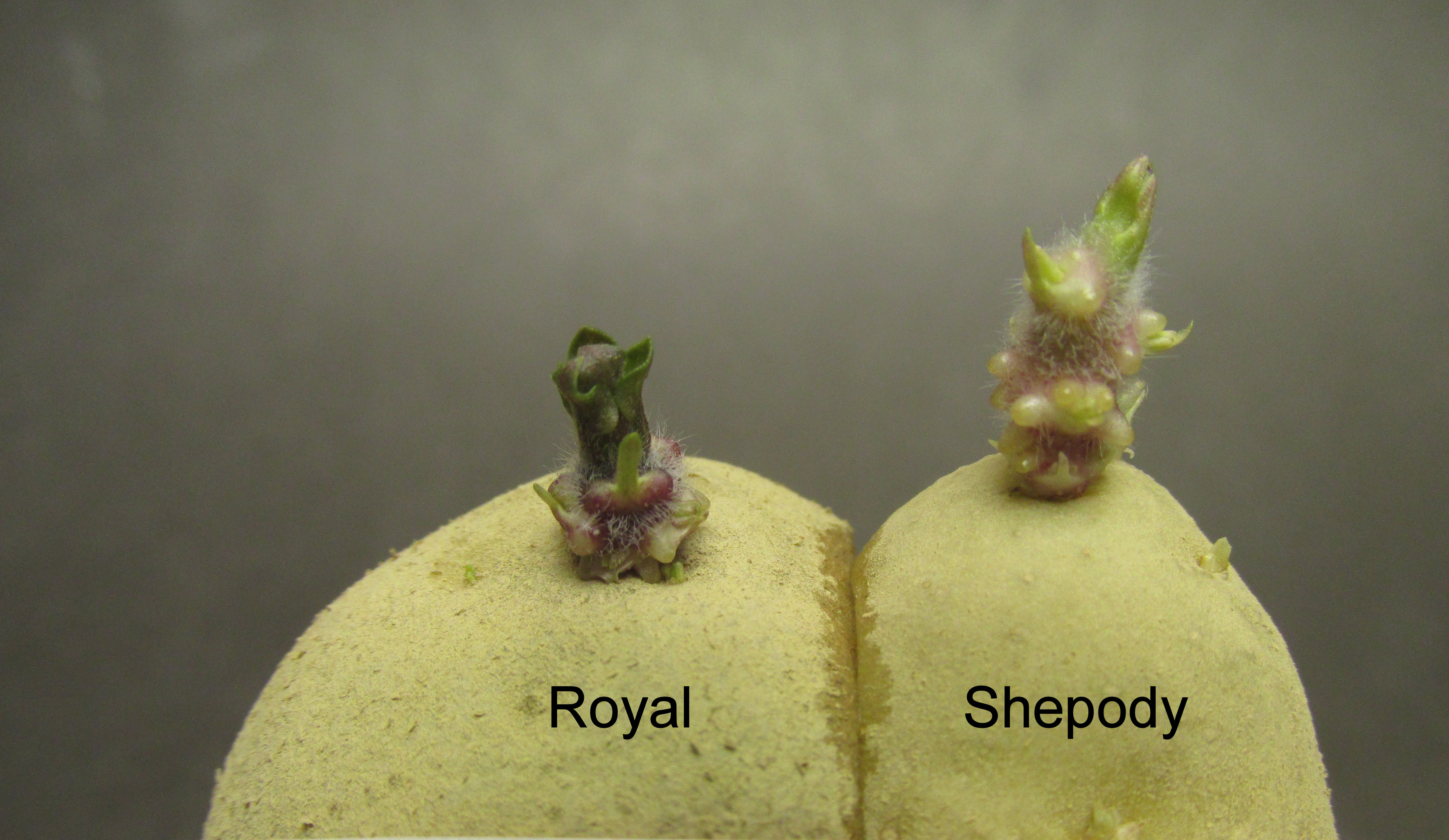Royal
| Denomination: | 'Royal' |
|---|---|
| Botanical Name: | Solanum tuberosum |
| Applicant/Holder: |
LKF-Vandel Grindstedvej Vandel DK-7184 Denmark |
| Breeder: |
LKF-Vandel, Vandel, Denmark |
| Agent in Canada: |
McCain Produce Inc. 8734 Main Street Unit 1 Florenceville-Bristol, New Brunswick E7L 3G6 Canada Tel: 506-392-2893 |
| Application Date: | 2015-02-26 |
| Application Number: | 15-8535 |
| Grant of Rights Date: | 2017-03-29 |
| Certificate Number: | 5465 |
| Exemption from compulsory licensing: | Yes |
| Expiry date for exemption from compulsory licensing: | 2019-03-29 |
| Grant of Rights Termination Date: | 2037-03-29 |
Variety Description
Variety used for comparison: 'Shepody'
Summary: The shape of the lightsprout of 'Royal' is spherical whereas the shape of the lightsprout of 'Shepody' is broad cylindrical. The intensity of anthocyanin colouration of the base of the lightsprout of 'Royal' is strong whereas the intensity is medium for 'Shepody'. The pubescence of the base of the lightsprout is of medium density for 'Royal' whereas the pubescence is dense for 'Shepody'. The anthocyanin colouration of the stem is absent for 'Royal' whereas the extent of anthocyanin colouration is low to medium for 'Shepody'. The frequency of inflorescences per plant is absent or very low to low for 'Royal' whereas the frequency is high for 'Shepody'. The size of the corolla of 'Royal' is small whereas the corolla of 'Shepody' is of medium size. The extent of anthocyanin colouration on the inner side of the corolla is low for 'Royal' whereas the extent is medium for 'Shepody'. The shape of the tuber of 'Royal' is short oval whereas the shape of the tuber of 'Shepody' is long oval to long. The colour of the tuber flesh of 'Royal' is light yellow whereas the tuber flesh of 'Shepody' is white. In reaction to light, the tuber skin of 'Royal' develops an absent or very weak intensity of anthocyanin colouration whereas the tuber skin of 'Shepody' develops a weak to medium intensity of anthocyanin colouration.
Description:
LIGHTSPROUT: medium size, spherical shape, few root tips, short lateral shoots
LIGHTSPROUT BASE: strong intensity of anthocyanin colouration, medium proportion of blue in anthocyanin colouration, medium density of pubescence
LIGHTSPROUT TIP: medium size in relation to base, intermediate between closed and open habit, medium intensity of anthocyanin colouration, sparse pubescence
PLANT: foliage structure is leaf type where foliage is closed and stems are hardly visible, semi-upright growth habit, mid-season to late maturity
STEM: no anthocyanin colouration
LEAF: outline is medium size, openness is intermediate between closed and open, medium green on upper side, absent or very low to low extent and absent or very weak to weak intensity of anthocyanin colouration on upper side of midrib, weak to medium presence of secondary leaflets, absent or very low frequency of coalescence of terminal and lateral leaflets
SECOND PAIR OF LATERAL LEAFLETS: small to medium size, leaflet is narrower than long
LEAFLET: absent or very weak waviness of margin, shallow to medium depth of veins, dull upper side, pubescent blade at apical rosette
INFLORESCENCE: absent or very low to low frequency per plant, small size
PEDUNCLE: absent or very low to low extent of anthocyanin colouration
FLOWER BUD: low extent of anthocyanin colouration
COROLLA: small
COROLLA (INNER SIDE): low extent of anthocyanin colouration, weak intensity of anthocyanin colouration, absent or low proportion of blue in anthocyanin colouration
TUBER: short oval shape, light yellow flesh
TUBER EYE: shallow to medium depth, yellow at base
TUBER SKIN: yellow, develops absent or very weak intensity of anthocyanin colouration in reaction to light
Origin & Breeding History: 'Royal' originated from the LKF-Vandel breeding program in Vandel, Denmark. It is the result of a hybridization conducted in 1997 between the variety 'Midas' and the selection designated '92 BUY-1'. The seed from the cross was planted in a greenhouse in 1998 and the resulting tubers were planted in the field in 1999. 'Royal' was selected in 1999 for its agronomic characteristics and resistance to various diseases.
Tests & Trials: The comparative trial for 'Royal' was conducted during the growing season of 2015 in Drummond, New Brunswick. The trial consisted of a single, 18.5 metre long row containing 60 plants spaced 0.3 metres apart for each variety. The distance between rows within the trial was 0.9 metres. Observations and measurements were taken from 10 plants, or 10 parts of plants, of each variety. Mean differences were significant at the 5% probability level based on a paired Student's t-test.
Click on image for larger view

Potato: 'Royal' (left) with reference variety 'Shepody' (right)
- Date modified: